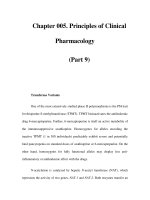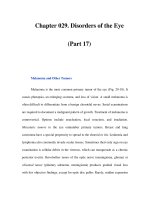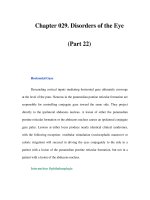Chapter 083. Cancer of the Skin (Part 9) ppt
Bạn đang xem bản rút gọn của tài liệu. Xem và tải ngay bản đầy đủ của tài liệu tại đây (44.66 KB, 5 trang )
Chapter 083. Cancer of the Skin
(Part 9)
Squamous Cell Carcinoma
The natural history of SCC depends on both tumor and host characteristics.
Tumors arising on actinically damaged skin have a lower metastatic potential than
those on protected surfaces. The metastatic frequency of cutaneous SCC, reported
at 0.3–5.2%, occurs most frequently in regional draining lymph nodes. Tumors
occurring on the lower lip and ear have metastatic potentials approaching 13 and
11%, respectively. The metastatic potential of SCC arising in scars, chronic
ulcerations, and genital or mucosal surfaces is higher. The overall metastatic rate
for recurrent tumors may approach 30%. Large, poorly differentiated, deep
tumors, with perineural or lymphatic invasion, often behave aggressively. Multiple
tumors with rapid growth and aggressive behavior can be a therapeutic challenge
in immunosuppressed patients.
Nonmelanoma Skin Cancer: Treatment
Basal Cell Carcinoma
The most frequently employed treatment modalities for BCC include
electrodesiccation and curettage (ED&C), excision, cryosurgery, radiation therapy,
laser therapy, Mohs micrographic surgery (MMS), topical 5-fluorouracil, and
topical immunomodulators. The mode of therapy chosen depends on tumor
characteristics, patient age, medical status, preferences of the patient, and other
factors. ED&C remains the method most commonly employed by dermatologists.
This method is selected for low-risk tumors (e.g., a small primary tumor of a less
aggressive subtype in a favorable location). Excision, which offers the advantage
of histologic control, is usually selected for more aggressive tumors or those in
high-risk locations or, in many instances, for aesthetic reasons. Cryosurgery
employing liquid nitrogen may be used for certain low-risk tumors but requires
specialized equipment (cryoprobes) to be effective for advanced neoplasms.
Radiation therapy, while not used as often, offers an excellent chance for cure in
many cases of BCC. It is useful in patients not considered surgical candidates and
as a surgical adjunct in high-risk tumors. Younger patients may not be good
candidates for radiation therapy because of the risks of long-term carcinogenesis
and radiodermatitis. Despite rapidly advancing technology in laser development,
their long-term efficacy in treating infiltrative or recurrent lesions is still unknown.
On the other hand, MMS, a specialized type of surgical excision that permits the
best histologic control and preservation of uninvolved tissue, is associated with
cure rates >98%. It is the preferred modality for lesions that are recurrent, in a
high-risk location, or large and ill-defined and where maximal tissue conservation
is critical (e.g., the eyelids). Topical 5-fluorouracil therapy should be limited to
superficial BCC. New topicals, the immunomodulators, show promise in their
efficacy at treating superficial and even nodular BCCs. Imiquimod, a relatively
well-tolerated cream, has successfully undergone phase III clinical trials.
Intralesional chemotherapy (5-fluorouracil and INF) and photodynamic therapy
(which employs selective activation of a photoactive drug by visible light) have
been used successfully in patients with numerous tumors. A topical endonuclease
(T4N5 liposome lotion) has been shown to repair DNA and may decrease the rate
of NMSC in xeroderma pigmentosum.
Squamous Cell Carcinoma
The therapy of cutaneous SCC should be based on an analysis of risk
factors influencing the biologic behavior of the tumor. These include the size,
location, and degree of histologic differentiation of the tumor as well as the age
and physical condition of the patient. Surgical excision, MMS, and radiation
therapy are standard methods of treatment. Cryosurgery and ED&C have been
used successfully for premalignant lesions and small primary tumors. Metastases
are treated with lymph node dissection, irradiation, or both. 13-cis-retinoic acid (1
mg orally every day) plus INF-α (3 million units subcutaneously or
intramuscularly every day) may produce a partial response in most patients.
Systemic chemotherapy combinations that include cisplatin may also be palliative
in some patients.
Prevention
As the vast majority of skin cancers are related to chronic UV radiation
exposure, patient and physician education could dramatically reduce their
incidence. Emphasis should be placed on preventive measures beginning early in
life. Patients must understand that damage from UV-B begins early, despite the
fact that cancers develop years later. Regular use of sunscreens and protective
clothing should be encouraged. Avoidance of tanning salons and midday (10
A.M.–2 P.M.) sun exposure is recommended.
Precancerous and in situ lesions should be treated early. Early detection of
small tumors affords simpler treatment modalities with higher cure rates and lower
morbidity. In patients with a history of skin cancer, long-term follow-up for the
detection of recurrence, metastasis, and new skin cancers should be emphasized.
Chemoprophylaxis using synthetic retinoids is useful in controlling new lesions in
some patients with multiple tumors.









